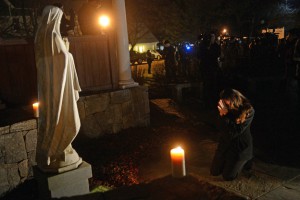
Emmanuel Dunand, Aline Marie outside St. Rose of Lima church in Newtown, CT on Dec. 14, the day of the shooting.
A recent NPR segment covered the dynamic between photographer and photographed subject in relation to tragedy. Read the following article on photojournalist Emmanuel Dunand’s photograph of Aline Marie shown in prayer the evening of the deadly shootings at Sandy Hook Elementary School in Newtown, CT. Read about Dunand’s experience of photographing those in grief and of Aline Marie’s reaction to the use of the picture to illustrate the tragedy. Do you think it’s appropriate for photographers to take pictures in these situations? You are welcome to critique this image or other photographs that raise similar ethical questions.
Link to NPR’s Photographed in a Moment of Grief
Don’t forget to log in to your OpenLab account and join the class (click on membership!).
To add a blog post, see instructions under “Blogging Guidelines” above.
Please share your responses with your classmates by Saturday, February 16 (in two weeks) February 23 (extended due to technical difficulties on the OpenLab).




There are a lot of photographers that cover stories and take pictures in very dangerous places and situations. These places could make them lose their lives. And most have families. It is all about which way it is seen. It depends really on the people taking the photo, the person in the photo, and the views of the people looking at the photo. No two views are the same and if it is possible, it is hard to find two people with the same view. Personally I think that it is appropriate for photographers to take pictures in any situation because it shows us the world from each and every view possible. And yet it should be common curtsy for someone to ask your name even if it’s after taking the photo.
To have a photo taken during a time of extreme sadness, especially after the death 20 kids and 6 adults in a small town community, without giving permission to the photographer is an invasion of privacy. The photographer that took this photo was a father of two. He was not looking forward to taking photos of these parents and friends that were suffering but it is the job of his and many others to take these profound photos. In today’s world, no one really wants their photo taken and out there without their permission or knowledge that it was taken. This is why it should be common knowledge and curtsy to ask for the person’s name. If it is chosen not to ask the name the least the photographer(s) of the media can do is tell the person I’m from so and so place.
I chose to google when is it appropriate to take someone’s photo and found this link http://www.photosecrets.com/photography-law-permission-do-i-need-permission , and it does say that if the photo is taken at a public place there is no need to ask the person for their name. But what would be the point of that photo if there is no backstory or information the photographer can give to farther supplement the photo?
I been used to something whenever you or someone is about to be filmed or photography, some kind of consent would be signed so that they can be filmed or photographed and be used for media purposes. The photographers committed themselves an invasion of privacy while the victim’s friends or family found themselves grieving. In the case that they were being used for media purposes, the photographers should have approached them for permission to be used for media purposes for press.
Although it wouldn’t have seemed realistic if they were approached for permission before the picture.
I’m somewhat in between two different emotions in regards to this article. I do believe that to take a candid picture the photographer does need to capture the moment that is taking place. Unfortunately that does mean that the subject will be captured without being notified. But, I also feel that when capturing a subject in an image it’s only appropriate for the photographer to ask permission or even notify the subject. In the circumstance of the shooting at Sandy Hook Elementary school, I’m torn on weather photojournalist Emmanuel Dunand was insensitive to the subject Aline Marie. I do believe that Emmanuel had no malicious doing behind the photo. That fact that he writes ” I have two kids.. it’s the type of story you never want to cover, ever, and being a dad.. all you want to do is put down flowers, you don’t want to take photos,” is my prime example of Emmanuel just being dealt a difficult task, covering the shooting. In my opinion, a candid photo was the only way to obtain the emotions being expressed that evening outside St. Rose of Lima church.